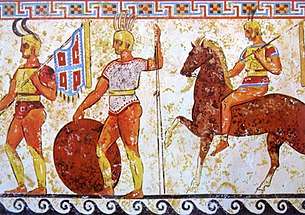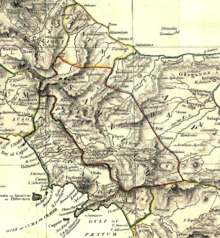Samnites
The Samnites were an ancient Italic people who lived in Samnium in south-central Italy. They became involved in several wars with the Roman Republic until the 1st century BC.
An Oscan-speaking people, the Samnites probably originated as an offshoot of the Sabines. The Samnites formed a confederation, consisting of four tribes: the Hirpini, Caudini, Caraceni, and Pentri. They allied with Rome against the Gauls in 354 BC, but later became enemies of the Romans and were soon involved in a series of three wars (343–341 BC, 327–304 BC, and 298–290 BC) against the Romans. Despite an overwhelming victory over the Romans at the Battle of the Caudine Forks (321 BC), the Samnites were eventually subjugated. Although severely weakened, the Samnites later helped Pyrrhus and some went over to Hannibal in their wars (280–275 BC and 218-201 BC) against Rome. They also fought from 91 BC in the Social War and later in the civil war (82 BC) as allies of Gnaeus Papirius Carbo against Lucius Cornelius Sulla, who defeated them and their leader Pontius Telesinus at the Battle of the Colline Gate (82 BC).[1] They were eventually assimilated by the Romans, and ceased to exist as distinct people.[2]
Etymology

The population of Samnium were called Samnites by the Romans. Their own endonyms were Safinim for the country (attested in one inscription and one coin legend) and Safineis for the people.[3]
Etymologically, the name Samnium is generally recognized to be a form of the name of the Sabines, who were Umbrians.[4] From Safinim, Sabinus, Sabellus and Samnis, an Indo-European root can be extracted, *sabh-, which becomes Sab- in Latino-Faliscan and Saf- in Osco-Umbrian: Sabini and *Safineis.[2] The eponymous god of the Sabines, Sabus, seems to support this view. The Greek terms, Saunitai and Saunitis, remain outside the group. Nothing is known of their origin.
At some point in prehistory, a population speaking a common language extended over both Samnium and Umbria. Salmon conjectures that it was common Italic and puts forward a date of 600 BC, after which the common language began to separate into dialects. This date does not necessarily correspond to any historical or archaeological evidence; developing a synthetic view of the ethnology of proto-historic Italy is an incomplete and ongoing task.
Linguist Julius Pokorny carries the etymology somewhat further back. Conjecturing that the -a- was altered from an -o- during some prehistoric residence in Illyria, he derives the names from an o-grade extension *swo-bho- of an extended e-grade *swe-bho- of the possessive adjective, *s(e)we-, of the reflexive pronoun, *se-, "oneself" (the source of English self). The result is a set of Indo-European tribal names (if not the endonym of the Indo-Europeans): Germanic Suebi and Semnones, Suiones; Celtic Senones; Slavic Serbs and Sorbs; Italic Sabelli, Sabini, etc., as well as a large number of kinship terms.[5]
History

The earliest written record of the people is a treaty with the Romans from 354 BC, which set their border at the Liris River. Shortly thereafter, the Samnite Wars broke out; they won an important battle against the Roman army in 321 BC, and their imperium reached its peak in 316 BC, after further gains from the Romans. By 290 BC, the Romans were able to break the Samnites' power after some hard-fought battles. The Samnites were one of the Italian peoples that allied with King Pyrrhus of Epirus during the Pyrrhic War. After Pyrrhus left for Sicily, the Romans invaded Samnium and were crushed at the Battle of the Cranita hills, but after the defeat of Pyrrhus, the Samnites could not resist on their own and surrendered to Rome. Some of them joined and aided Hannibal during the Second Punic War, but most stayed loyal to Rome. The Samnites and several other Italic people rebelled against Rome and started the Social War, after Romans refused to grant them Roman Citizenship. The war lasted almost four years, and resulted in a Roman victory. However, Samnites and other Italic tribes were granted Roman citizenship, to avoid another war. The Samnites supported the Populares in the civil war against Lucius Cornelius Sulla, but unfortunately for them, Sulla ended up winning the war and was declared the dictator of Rome. Sulla ordered all those who went against him to be punished. Thousands of people in Rome and all over Italy were brutally hunted down and killed. Samnites, who were some of the most prominent supporters of the Populares, were punished so severely that it was recorded "some of their cities have now dwindled into villages, some indeed being entirely deserted." Samnites did not play any prominent role in history after this, and they eventually became Latinized and assimilated into the Roman World [6][2]
Notable Samnites
Gentes of Samnite origin
Leaders of the Samnites
- Gaius Pontius ca. 320s BC
- Gellius Egnatius ca. 296 BC
Uprising against Sulla
- Gaius Papius Mutilus 90-89
Romans of Samnite origin
- Cassius Longinus - assassin of Julius Caesar
- Pontius Pilate - the 5th Prefect of the Roman province of Judaea from AD 26–36. He ordered the crucifixion of Jesus
Notes
- "Samnite (people)". Encyclopædia Britannica Online. Encyclopædia Britannica, Inc. Retrieved 29 November 2012.
- Edward Togo Salmon (1967). Samnium and the Samnites. Cambridge University Press. p. 30. ISBN 978-0-521-06185-8.
- Salmon 1967, p. 28.
- Salmon 1967, p. 29.
- Pokorny 1959, pp. 882–884 under se.
- Strabo, Geography, Book V, Section 4.11.
References
- Salmon, Edward Togo. Samnium and the Samnites. Cambridge, UK: Cambridge University Press, 1967.
Further reading
- Forsythe, Gary. A Critical History of Early Rome: From Prehistory to the First Punic War. Berkeley: University of California Press, 2005.
- Jones, Howard. Samnium: Settlement and Cultural Change: the Proceedings of the Third E. Togo Salmon Conference On Roman Studies. Providence, RI: Center for Old World Archaeology and Art, 2004.
- Paget, R. F. Central Italy: An Archaeological Guide; the Prehistoric, Villanovan, Etruscan, Samnite, Italic, and Roman Remains, and the Ancient Road Systems. 1st U.S. ed. Park Ridge, NJ: Noyes Press, 1973.
- Salvucci, Claudio R. A Vocabulary of Oscan: Including the Oscan and Samnite Glosses. Southampton, Pa.: Evolution Pub., 1999.
- Stek, Tesse. Cult Places and Cultural Change In Republican Italy: A Contextual Approach to Religious Aspects of Rural Society After the Roman Conquest. Amsterdam: Amsterdam University Press, 2010.
External links
| Library resources about Samnites |
- The Battles of Bovianum, 311 BC - article about a problematical campaign of the Second Samnite War
- The Samnite Pilum
- Warriors of the Samnite Wars